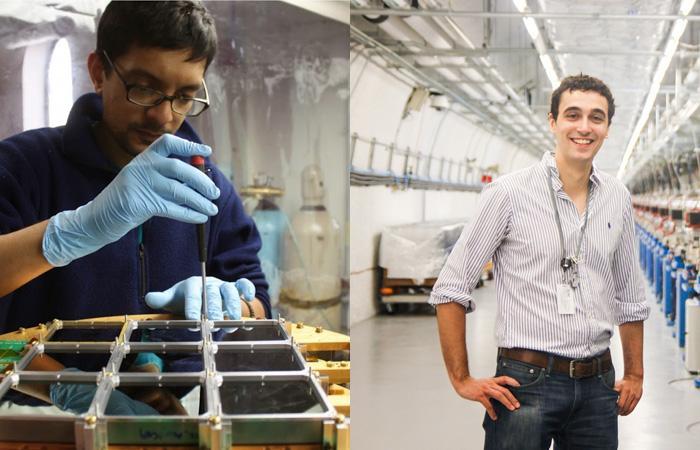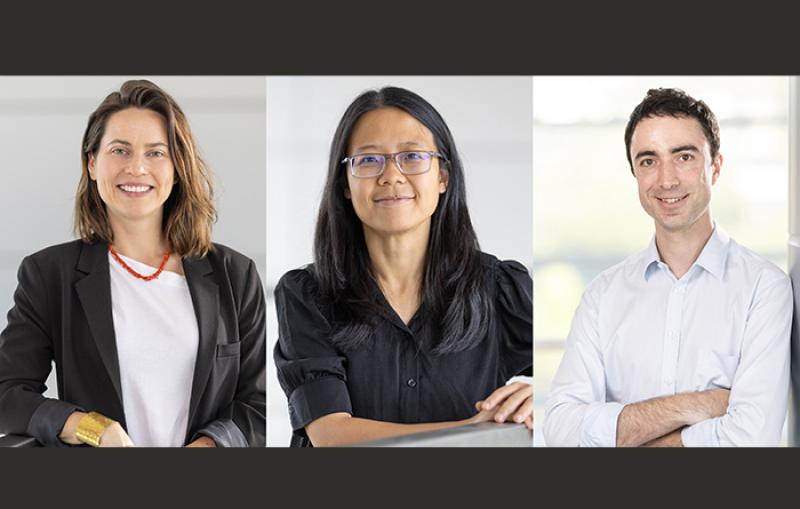Agostino Marinelli, Zeeshan Ahmed Named 2015 Panofsky Fellows at SLAC
The fellowship will support their research on new capabilities for the lab's X-ray free-electron lasers and new telescope technology to look for signs of cosmic inflation.
Agostino Marinelli, an associate staff scientist at the Department of Energy's SLAC National Accelerator Laboratory, and Stanford University postdoctoral researcher Zeeshan Ahmed were recently named 2015 Panofsky Fellows at SLAC. The prestigious five-year Wolfgang K. H. Panofsky Fellowship honors the lab's founder and first director. It recognizes exceptional and promising young scientists who would most benefit from the opportunity to conduct their research at SLAC, with a particular emphasis on the potential for innovation and growth of new opportunities.

“In expanding the original focus of the Panofsky Fellowship from high-energy physics to the full breath of scientific research at SLAC, our intent is to attract some of the brightest young scientists available and to encourage pursuit of their new research ideas for the laboratory,” said SLAC Director Chi-Chang Kao.
Marinelli, an accelerator physicist who joined SLAC's Accelerator Research Division in 2012, led the development of new modes of operation at the lab's Linac Coherent Light Source X-ray free-electron laser (LCLS) that can deliver pairs of tightly spaced X-ray pulses, each tuned to a specific “color” or wavelength. This development allows entirely new “pump-probe” techniques, enabling researchers to excite samples with the leading X-ray pulse and then measure changes with the second pulse. The techniques have broad applications in biology, chemistry and materials research.
He has also conducted electron-beam research at SLAC’s Next Linear Collider Test Accelerator.
During his fellowship, he plans to develop exciting new capabilities for LCLS and its LCLS-II upgrade, including ultrashort-pulse techniques that use lasers to manipulate and finely segment electron bunches, and will also work on other R&D to support advanced accelerator and FEL experiments.
He received his PhD in physics from the University of California, Los Angeles, in 2012 and was honored with the European Physical Society's 2014 Frank Sacherer Prize for his early-career contributions to accelerator science, as well as the American Physical Society's 2015 Outstanding Doctoral Thesis Research in Beam Physics Award.
“It is a great honor to be included with my colleagues who have won the Panofsky Fellowship," Marinelli said. "I look forward to starting these new projects and strengthening the collaboration between accelerator physicists and the scientists using the LCLS.”
Ahmed led the design, testing, construction and deployment of the recently commissioned SLAC and Stanford BICEP3 telescope at the South Pole as a postdoctoral scholar on Chao-Lin Kuo's observational cosmic microwave background (CMB) research team at Stanford. BICEP3 is the third generation of instruments scientists are using to look for patterns in the CMB as evidence of cosmic inflation and represents a 10-fold improvement in capability over BICEP2.
Prior to joining Stanford, he conducted graduate research on the second-generation Cryogenic Dark Matter Search, CDMS-II, leading the primary analysis of the final dataset. Ahmed received his PhD in physics from California Institute of Technology in 2012.
In the coming years, he plans to continue research to improve the sensitivity of CMB telescopes and enable the development of large arrays of such telescopes. "The goal is to conduct deeper searches for inflation signals amidst astrophysical foregrounds and also to improve our understanding of large-scale structure and cosmology using the CMB," he said.
“It is an exciting time to go hunting for inflation, despite the challenge of foregrounds revealed by recent joint-analysis results from BICEP2/Keck Array and Planck. Just in the last couple of years, we’ve made significant instrumentation and analysis advancements to dig deeper into inflation parameter space. Future CMB surveys will also provide insight into neutrino properties. There is an opportunity here for SLAC to grow into a leader in upcoming CMB surveys and science, and I am honored to be appointed as a Panofsky fellow at the lab to pursue this research.”
The appointments were awarded by SLAC Director Chi-Chang Kao following a lab-wide selection process.
"We recognize the outstanding contributions of these young researchers and expect great things of their work at SLAC in the coming years," Kao said. "These fellowships cultivate the creativity and high achievement that were characteristic of Pief Panofsky's visionary leadership, and help advance the lab's mission in key scientific pursuits."
Since the fellowship's inception in 1989, there have been 13 fellows performing research at SLAC in the fields of experimental and theoretical particle physics, astrophysics and accelerator physics. This year the scope of the Panofsky Fellowship was expanded to encompass the full range of scientific research at SLAC. Panofsky Fellows have gone on to play important roles in their fields as members of the faculty and staff of prominent institutions.
Contact
For questions or comments, contact the SLAC Office of Communications at communications@slac.stanford.edu.
SLAC is a vibrant multiprogram laboratory that explores how the universe works at the biggest, smallest and fastest scales and invents powerful tools used by scientists around the globe. With research spanning particle physics, astrophysics and cosmology, materials, chemistry, bio- and energy sciences and scientific computing, we help solve real-world problems and advance the interests of the nation.
SLAC is operated by Stanford University for the U.S. Department of Energy’s Office of Science. The Office of Science is the single largest supporter of basic research in the physical sciences in the United States and is working to address some of the most pressing challenges of our time.





